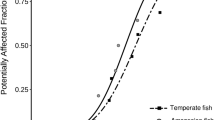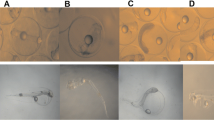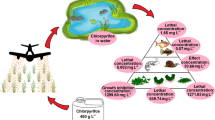Abstract
Ninety-six-hour LC50 values were determined for 10 chlorinated aliphatic hydrocarbons in freshwater flow-through toxicity tests on fathead minnows (Pimephales promelas). The 96-hr measured LC50 values in mg/L from combined duplicate tanks were: tetrachloroethylene 13.4; 1,1′,2,2′-tetrachloroethane 20.4; pentachloroethane 7.34; 1,1′,2-trichloroethane 81.6; hexachlorobutadiene 0.10; 1,1′2-trichloroethylene 45.0; 1,2-dichloropropane 140; 1,2-dichloroethane 116; hexachloroethane 1.51; 1,3-dichloropropane 131.
Similar content being viewed by others
References
Adema, D. M. M.:Daphnia magna as a test animal in acute and chronic toxicity tests. Hydrobiologia59, 125 (1978).
Alexander, H. C., W. M. McCarty, and E. A. Bartlett: Toxicity of perchloroethylene, trichloroethylene, and methylene chloride to fathead minnows. Bull. Environ. Contam. Toxicol.20, 344 (1978).
APHA (American Public Health Association), American Water Works Association, and Water Pollution Control Federation: Standard methods for the examination of water and wastewater. 15 ed. Washington, DC: American Public Health Assoc. (1980).
Barrows, M. E., S. R. Petrocelli, K. J. Macek, and J. J. Carroll: Bioconcentration and elimination of selected water pollutants by bluegill sunfish (Lepomis macrochirus). Dynamics, exposure and hazard assessment of toxic chemicals, (Pap. Symp.) Meeting date 1978, Pub. by Ann Arbor Sci., Ann Arbor, MI (1980).
Benoit, D. A., F. A. Puglisi, and D. L. Olson: A fathead minnow (Pimephales promelas) early life stage toxicity test method evaluation and exposure to four organic chemicals. J. Environ. Pollut.28, 189 (1982).
Canton, J. H., and D. M. M. Adema: Reproducibility of short-term and reproduction toxicity experiments withDaphnia magna and comparison of the sensitivity ofDaphnia magna withDaphnia pulex andDaphnia cucullata in short-term experiments. Hydrobiologia59, 135 (1978).
Dawson, G. W., A. L. Jennings, D. Drozdowski, and E. Rider: The acute toxicity of 47 industrial chemicals to fresh and saltwater fishes. J. Hazard. Mater.1, 303 (1975/77).
DeFoe, D.: Unpublished data. U.S. Environmental Research Laboratory, Duluth, MN 55804.
Hamilton, M. A., R. C. Russo, and R. V. Thurston: Trimmed Spearman-Karber method for estimating median lethal concentrations in toxicity bioassays. Environ. Sci. Technol.11, 714 (1977). Correction12, 417 (1978).
Hawley, G. G. (ed.): Condensed chemical dictionary, 9 ed. New York-London: Van Nostrand Reinhold 1977.
Johnson, W. W., and M. T. Finley: Handbook of acute toxicity of chemicals to fish and aquatic invertebrates. U.S. Dept. of Interior, Fish and Wildlife Serv., Resource Pub. 137, Washington, DC (1980).
Laska, A. L., C. K. Bartell, D. B. Condie, J. W. Brown, R. L. Evans, and J. L. Laseter: Acute and chronic effects of hexachlorobenzene and hexachlorobutadiene on red swamp crayfish (Procambrus clarki) and selected fish species. Toxicol. Applied Pharmacol.43, 1 (1978).
LeBlanc, G. A.: Acute toxicity of priority pollutants to water flea (Daphnia magna). Bull. Environ. Contam. Toxicol.24, 684 (1980).
Mount, D. I., and W. A. Brungs: A simplified dosing apparatus for fish toxicology studies. Water Res.1, 21 (1967).
Phipps, G. L., G. W. Holcombe, and J. T. Fiandt: Saturator system for generating toxic water solutions for aquatic bioassays. Prog. Fish-Cult.44, 115 (1982).
Richter, J.: Unpublished data. U.S. Environmental Research Laboratory, Duluth, MN 55804.
Rosenberg, R., O. Grahn, and L. Johansson: Toxic effects of aliphatic chlorinated by-products from vinyl chloride production on marine animals. Water Res.9, 607 (1975).
Sloof, W.: Detection limits of a biological monitoring system based on fish respiration. Bull. Environ. Contam. Toxicol.23, 517 (1979).
U.S. Environmental Protection Agency: Committee on Methods for Toxicity Tests with Aquatic Organisms. Methods for acute toxicity tests with fish, macroinvertebrates, and amphibians. Ecol. Res. Ser, EPA 660/3-75-009 (1975), NTIS No. PB242105 (National Technical Information Service, Springfield, VA 22161).
-: Ambient water quality criteria for chlorinated ethanes. EPA 440/5-80-029 (1980a), NTIS No. PB81-117400.
-: Ambient water quality criteria for dichloropropane and dichloropropene. EPA 440/5-80-043 (1980b), NTIS No. PB81-117541.
-: Ambient water quality criteria for hexachlorobutadiene. EPA 440/5-80-053 (1980c), NTIS No. PB81-117640.
-: Ambient water quality criteria for tetrachloroethylene. EPA 440/5-80-073 (1980d), NTIS No. PB81-117830.
-: Ambient water quality criteria for trichloroethylene. EPA 440/5-80-077 (1980e), NTIS No. PB81-117871.
—: Methods for chemical analysis of water and wastes. Washington, DC: U.S. Environmental Protection Agency, Office of Technology Transfer (1974).
Author information
Authors and Affiliations
Rights and permissions
About this article
Cite this article
Walbridge, C.T., Fiandt, J.T., Phipps, G.L. et al. Acute toxicity of ten chlorinated aliphatic hydrocarbons to the fathead minnow (Pimephales promelas). Arch. Environ. Contam. Toxicol. 12, 661–666 (1983). https://doi.org/10.1007/BF01060748
Received:
Revised:
Issue Date:
DOI: https://doi.org/10.1007/BF01060748




